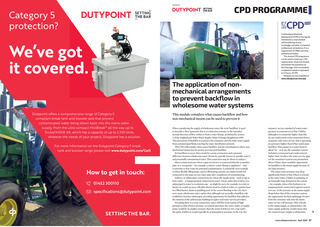


SPONSOR CPD PROGRAMME Continuing professional development (CPD) is the regular maintenance, improvement and broadening of your knowledge and skills, to maintain professional competence. It is a requirement of CIBSE and other professional bodies. This Journal CPD programme can be used to meet your CPD requirements. Study the module and answer the questions on the final page. Each successfully completed module is equivalent to 1.5 hours of CPD. Modules are also available at www.cibsejournal.com/cpd The application of nonmechanical arrangements to prevent backflow in wholesome water systems This module considers what causes backflow and how non-mechanical means can be used to prevent it When considering the supply of wholesome water, the term backflow is used to describe a flow upstream, that is in a direction contrary to the intended normal direction of flow, within or from a water fitting, as defined by section 2 of the England and Wales Water Supply (Water Fittings) Regulations 1999. The prevention of backflow is to protect the consumer and the wider water supply from contaminated fluids entering the water distribution network. This CPD will consider what causes backflow and the circumstances where nonmechanical means may be used to prevent such backflow. For backflow to occur, there needs be a cross-connection and a pressure difference between wholesome water (formerly typically known as potable water), and potentially contaminated water. This connection may be direct or indirect. Direct connections are where a pipe (or device) is connected directly to another pipe, or a receptacle for example, a cistern, vessel, fitting or appliance5 and so provides a clear route for potential contamination. A commonly seen example is where flexible filling loops, used to fill heating systems, are inadvertently left connected to the main service water pipe after completion of commissioning. Indirect, or submerged, connections are where the supply point such as tap or hose outlet is inappropriately immersed in water. A hose outlet that is left to rest submerged in water is a common case as might be seen, for example, in a sink or bucket in a wash-up area; a flexible shower head in a bath or toilet; or a garden hose in a filled bucket, drain or paddling pool. In the recent flooding in the UK, there were many wholesome water outlets that, although not normally a backflow risk, would have become submerged, providing opportunity for backflow that added to the miseries of the unfortunate building occupiers and water service providers. Providing there is a cross-connection, water will flow from a point of high pressure to that of lower pressure. In normal operation, the water outlet, or supply point, would be at a higher pressure than the point of delivery. For a tap outlet, the point of delivery would typically be at atmospheric pressure. In the UK, the statutory1 service standard of mains water pressure to consumers is 0.7bar (70kPa), although it is commonly higher than this. So, any inadvertent cross-connection from a consumer-side water service that is operating at a pressure higher than 0.7bar could cause backflow. This equates to a water head of about 7m so if, say, the consumer system included a connected water tank (cistern) higher than 7m above the water-service pipe (or the consumers system was pressurised above 0.7bar), there would be opportunity for backflow to the mains supply because of the back pressure. The mains water pressure may drop significantly below 0.7bar if there is a break in the water main, a failure in pumping, or an unusually large demand on the system for example, when a fire hydrant or an inappropriately connected irrigation system is in use. As the pressure in the mains supply drops below that of the consumer system, the opportunity for back siphonage of water from the consumer side into the mains water service will increase. After a break to the mains supply, or maintenance, the water supply authority would ensure that the restored water supply is wholesome. www.cibsejournal.com April 2020 57 CIBSE Apr20 pp57-60 CPD v3.indd 57 20/03/2020 16:30